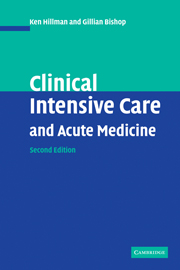Book contents
- Frontmatter
- Contents
- List of troubleshooting tips
- Preface to the first edition
- Preface to the second edition
- Acknowledgements
- 1 A systematic approach to caring for the seriously ill
- 2 Organisation of an intensive care unit
- 3 Routine care of the seriously ill
- 4 Fluid therapy and electrolytes
- 5 Nutrition and metabolism
- 6 Acid–base balance
- 7 Sedation, analgesia and muscle relaxants
- 8 Shock and anaphylaxis
- 9 Multiorgan failure
- 10 Cardiopulmonary resuscitation
- 11 Body temperature disorders
- 12 Transport of the seriously ill
- 13 Infection
- 14 Trauma
- 15 Poisoning
- 16 Acute respiratory failure
- 17 Interpretation of the portable chest film
- 18 Specific respiratory problems
- 19 Ventilatory techniques
- 20 Cardiorespiratory monitoring
- 21 Acute cardiovascular failure
- 22 Specific cardiovascular problems
- 23 Acute intracranial disasters
- 24 Specific intracranial problems
- 25 Critical care neurology
- 26 Acute renal failure
- 27 Critical care gastroenterology
- 28 Critical care haematology
- 29 Critical care endocrinology
- 30 Obstetric emergencies
- 31 Economics, outcome and ethics in intensive care
- Appendices
- Index
- References
18 - Specific respiratory problems
Published online by Cambridge University Press: 07 September 2009
- Frontmatter
- Contents
- List of troubleshooting tips
- Preface to the first edition
- Preface to the second edition
- Acknowledgements
- 1 A systematic approach to caring for the seriously ill
- 2 Organisation of an intensive care unit
- 3 Routine care of the seriously ill
- 4 Fluid therapy and electrolytes
- 5 Nutrition and metabolism
- 6 Acid–base balance
- 7 Sedation, analgesia and muscle relaxants
- 8 Shock and anaphylaxis
- 9 Multiorgan failure
- 10 Cardiopulmonary resuscitation
- 11 Body temperature disorders
- 12 Transport of the seriously ill
- 13 Infection
- 14 Trauma
- 15 Poisoning
- 16 Acute respiratory failure
- 17 Interpretation of the portable chest film
- 18 Specific respiratory problems
- 19 Ventilatory techniques
- 20 Cardiorespiratory monitoring
- 21 Acute cardiovascular failure
- 22 Specific cardiovascular problems
- 23 Acute intracranial disasters
- 24 Specific intracranial problems
- 25 Critical care neurology
- 26 Acute renal failure
- 27 Critical care gastroenterology
- 28 Critical care haematology
- 29 Critical care endocrinology
- 30 Obstetric emergencies
- 31 Economics, outcome and ethics in intensive care
- Appendices
- Index
- References
Summary
Cardiogenic pulmonary oedema
Cardiogenic pulmonary oedema is usually seen in the setting of acute left ventricular failure (LVF) in association with ischaemic heart disease (IHD).
Cardiogenic pulmonary oedema as an accompaniment to LVF can result from conditions such as acute myocardial infarction (AMI), arrhythmias, cardiac tamponade and valvular abnormalities. However, no specific cause is obvious in the majority of cases. This is especially true with paroxysmal nocturnal dyspnoea or ‘flash’ pulmonary oedema. The oedema presents acutely, often at night, with the patient suddenly waking up breathless. These patients typically are old, with histories of IHD and hypertension. Many of these patients have normal systolic function and it is thought that the cause of the pulmonary oedema is left ventricular diastolic dysfunction. The precipitating event may be silent myocardial ischaemia. Patients with acute cardiogenic pulmonary oedema often have accompanying tachycardia, hypertension and hypoxia which in turn will increase left ventricular dysfunction and exacerbate the pulmonary oedema. Moreover, the increased work of breathing and the increased inspiratory effort can, in themselves, further exacerbate the oedema (Figure 18.1).
Investigations, diagnosis and monitoring
The history and examination should strongly suggest the diagnosis.
Chest x-ray will demonstrate Kerley B lines; thickened fissures; peribronchial cuffing; increased vessel diameter and upper lobe diversion, a perihilar bat wing appearance, pleural effusions and intrapulmonary shadowing often with cardiomegaly.
Examine 12-lead ECG to exclude ischaemia, AMI, etc.
Measure arterial blood gases to determine extent of gas exchange abnormality and acidosis.
Cardiac enzymes to exclude AMI.
Monitor vital signs (e.g. arterial BP, pulse rate, respiratory rate and urine output).
[…]
- Type
- Chapter
- Information
- Clinical Intensive Care and Acute Medicine , pp. 325 - 376Publisher: Cambridge University PressPrint publication year: 2004



